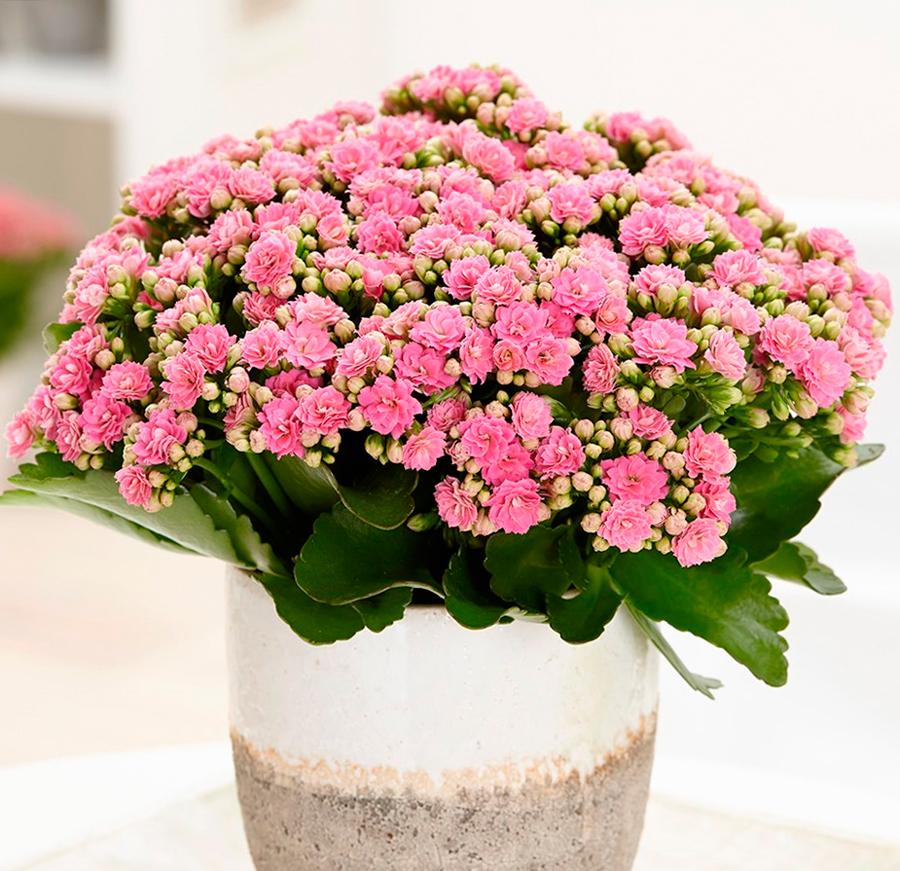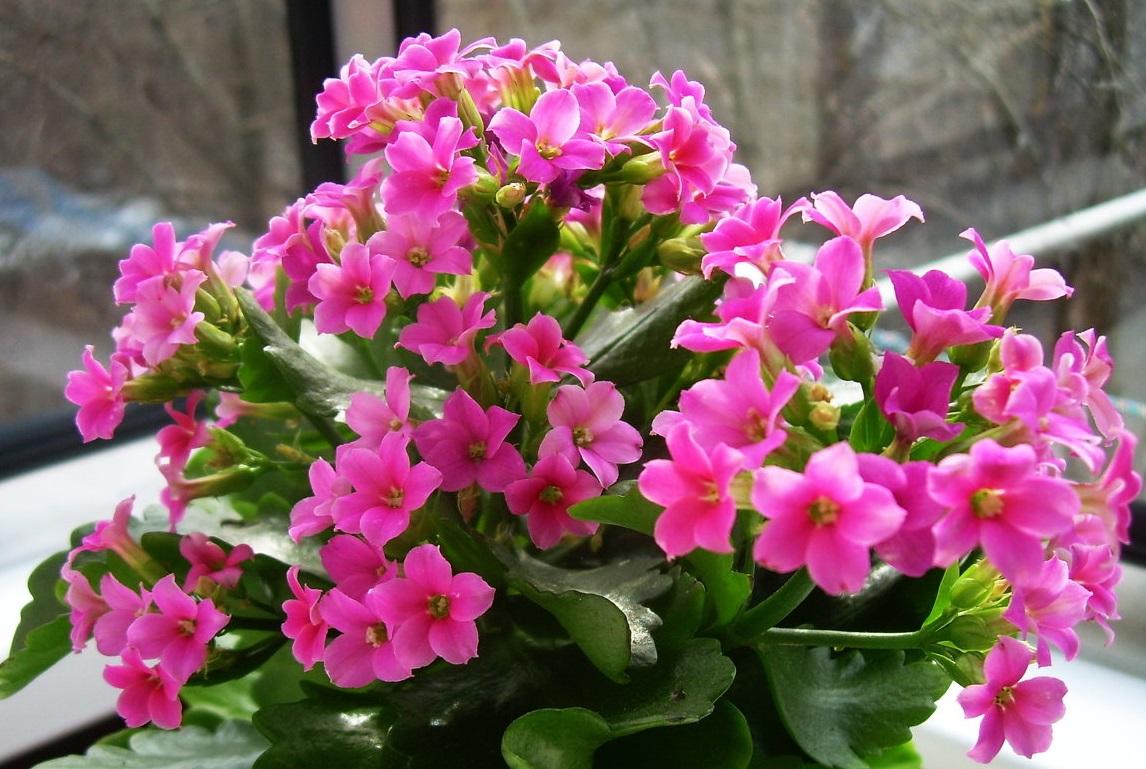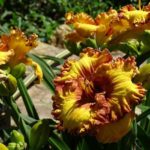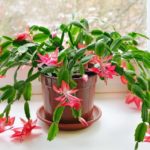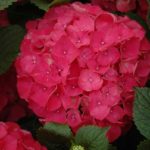Kalanchoe flowering is an unpretentious plant that fits perfectly into any interior. At the same time, culture does not always please its owners with colorful paints. Sometimes the plant does not bloom at all. It is not difficult to achieve lush and abundant flowering. It is important to create suitable conditions for this. Planting and caring for flowering Kalanchoe at home has a number of features.
Description of the plant
Kalanchoe is a crop from the Crassulaceae family. This genus includes more than 200 species. They are represented by succulents, subshrubs and herbaceous perennials. Under natural conditions, this crop grows in the tropics of America, Australia, and Asia. The leaves differ from species to species. They are usually quite thick. Sessile leaves or with petioles are also found. They can be strongly or weakly dissected.
During the flowering period, umbrellas are formed on the bushes, which include flowers of different shades - yellow, purple, white, red. You can grow different types of this crop at home. Among the flowering ornamental varieties, it is worth highlighting the following:
- Blossfeld - has high decorative properties. The plant forms compact bushes. During the flowering period, spectacular umbrella-shaped inflorescences appear on them. The most popular variety series is Kalanchoe Kalandiva. It is characterized by double flowers.
- Degremona – has medicinal properties. The juice from the fleshy leaves of the plant is used to combat the common cold and heal wounds. This culture belongs to bryophyllum. This term refers to viviparous Kalanchoes that reproduce by babies.
- Cirrus also has medicinal properties. The oval leaves of the crop are covered with a pattern of veins. This makes them look like feathers. This is what the name of the plant is associated with.
- Mangina is a decorative bryophyllum that has long shoots. This flower grows in the form of an ampelous bush. During the flowering period, red bell-shaped flowers are formed on the plant.
- Tubiflora is a rather interesting bryophyllum, which has narrow leaves tucked inward. A large number of babies are formed along their edges.
- Dissected – This flower is also called “deer horns”. It is characterized by long shoots that have narrow dissected leaves. In appearance they look like deer antlers.
There are also a large number of other types of such flowers - felt, paniculate and others. However, these plants are planted much less frequently. At the same time, you can grow any flower at home. To do this, you need to follow a number of rules.
Nuances of care and cultivation
For a plant to look attractive, it needs to be properly cared for. It is important to take into account certain features.
Lighting selection
Under natural conditions, many types of Kalanchoe grow in open, well-lit areas. Therefore, at home, plants should also be kept in bright light. However, from too much sun the leaves may turn reddish. Therefore, the light should be slightly diffused.
In the shade, the culture will also survive, but will become very elongated. At the same time, the upper leaves will become less bright and turn pale, and the lower ones will even begin to crumble. In this case, flowering may not begin at all. So, when choosing a place for Kalanchoe, you should take into account the recommendations of experienced gardeners:
- In spring and summer, place the flower on windowsills that are located on the southwest or southeast side.
- In the fall, move the pot to a south window and keep it there until spring. If necessary, in cloudy weather, additional lighting can be provided. For this it is recommended to use phytolamps.
Temperature
Kalanchoe develops well at a temperature of +15-24 degrees. In winter, it needs to be moved away from the battery. The fact is that an excessive amount of heat will lead to the loss of decorativeness of the plant.The buds of the culture are laid at parameters of +15-18 degrees.
How and when to water
The plant needs to be watered sparingly throughout the summer. The soil surface should dry out between waterings. In winter, the soil may almost dry out, but the crop still needs to be watered. It is important to control the appearance of the fleshy leaves. If they become lethargic and dull, the amount of moisture should be reduced. If the foliage noticeably withers, watering should be increased.
Spraying
The crop does not need spraying. It grows well at standard air humidity. At the same time, in hot weather the bush can be additionally moistened. This will have a beneficial effect on the plant. The flower has fleshy leaf blades. Sometimes their surface is covered with fluff. Therefore, the evaporation of moisture occurs extremely slowly.
Do I need to fertilize?
It is recommended to feed the flower with mineral preparations and organic matter. Such means should be alternated. It is recommended to apply fertilizers in moderation. This is especially true when using nitrogen preparations.
At the dormant stage, the amount of fertilizing should be reduced to a minimum. Otherwise, the Kalanchoe will begin to grow green mass, which will lead to problems with flowering. After the buds appear on the flower, you should start adding potassium and phosphorus. During the flowering period, the crop should be fed with cactus compounds.
Pruning requirements
Kalanchoe is a fast-growing flower. Over the course of a year, the plant greatly increases in size and loses its shape. After flowering ends, the plant sheds its lower leaves. Therefore, at this stage it is necessary to carry out deep pruning. On young flowers you need to pinch off the leaves. Kalanchoe with developed roots should be cut off almost completely.
Bloom
In order for the plant to bloom magnificently, the duration of daylight in spring and summer should not exceed 10-12 hours. However, the lighting must be quite bright. You can also cut flowers and place them in a vase with water. They can stand there for quite a long time. After flowering ends, some of the shoots can be cut off. This will help improve the shape of the bush. If necessary, cut stems can be rooted.
Sometimes Kalanchoe does not bloom. This may be due to the following factors:
- Violation of lighting conditions. In nature, this crop grows in a tropical climate. There, daylight hours last throughout the year for 12 hours. In the temperate zone, its duration does not exceed 5-6 hours. Therefore, in winter and autumn it is important to provide the plant with additional lighting.
- Temperature violation. For the plant to bloom, it requires a temperature of +16-18 degrees. To do this in winter you need to place the flower in a cool place. An insulated loggia is perfect for this.
- Unsuitable soil. For growing the crop, a self-made or ready-made substrate for succulents is suitable. It can be neutral or slightly acidic. To achieve abundant flowering of the plant, it requires additional feeding.
- Violation of the watering regime. In spring and summer, the soil is moistened twice a week. In autumn and winter, 1 watering every 7 days is sufficient. It is recommended to spray the crop only in hot weather. If a flower drops its leaves, this means that the soil has dried out.
How to replant a plant
It is recommended to replant the plant only if the bush grows strongly and becomes cramped in the pot. To do this, you need to take a new container and pour crushed brick or expanded clay onto the bottom. These materials perform drainage functions and prevent moisture stagnation.Then the pot needs to be half filled with the prepared substrate. To prepare it, you need to mix peat, sand, turf soil and deciduous soil in a ratio of 1:1:4:2.
How to propagate
The following methods can be used to propagate Kalanchoe:
- Cuttings. It is best to harvest planting material in spring or summer. At the same time, cuttings cut and planted in the fall will also give good results. To propagate the plant, it is recommended to use cut tops. However, if necessary, the long stem can also be divided into parts. Such fragments will most likely take root.
- Using leaves. It is recommended to root leaves in the summer. To do this, they need to be carefully cut from a healthy shoot. It is important to take into account that it will take longer to grow a full-fledged plant from a leaf than from a cutting.
- With the help of children. Many types of Kalanchoe form babies on the side of the plate. At first, it feels like small leaves have appeared there. However, over time, they turn into small rosettes and grow their roots. At this stage, the children can be separated and rooted.
Sometimes the plant is propagated by seed. In this case, it is recommended to plant the grains at the end of winter or early spring. To do this, take a container and fill it with leafy substrate. After that, you need to evenly distribute the seeds on the surface and press them with your finger into the substrate. There is no need to fill the soil with soil mixture.
The container should be covered with glass and a sheet of paper.In this case, the plantings need to be systematically ventilated in the morning and evening. It is of no small importance to maintain the correct temperature regime at +16-20 degrees. It is also recommended to water the plants on time with warm water, making sure that the soil does not dry out completely.
After the sprouts appear, the cover must be removed from the container. When the seedlings are 20-30 days old, they are dived into larger containers. Another transplant is needed after the formation of the third or fourth leaf plate. It is recommended to provide a full drainage layer at the bottom of the pots.
To plant seedlings, you need to use a special substrate. It should consist of turf, sand and peat. These components are mixed in a ratio of 2:1:4. After the transplanted seedlings have adapted to their new location, they need to be pinched off at the top. This will make the bush more branched and lush.
The next transplant is carried out when the plant becomes cramped in the pot. At this stage, it is recommended to use soil based on humus, sand, deciduous soil and compost. The first flowering of a young bush will begin next year.
Pros and cons of Kalanchoe
The main advantages of this culture include the following:
- low maintenance requirements;
- beautiful flowering;
- resistance to heat and drought.
At the same time, the flower also has some disadvantages. The main disadvantages of the plant include the following:
- lack of resistance to moisture stagnation;
- risk of lack of flowering;
- the likelihood of the bush being pulled out.
Possible pests and their control
Sometimes the bushes become covered with insects that absorb their juices. As a result, plants become weak, begin to get sick and may even die. In addition, there is a possibility of damage to nearby bushes.That is why it is so important to detect and destroy parasites in a timely manner.
To cope with the problem, you can use insecticides or acaricides. To do this, you need to make a working solution in accordance with the instructions and spray the flower. Usually there is a need for several treatments, which are carried out at a certain interval.
Most often, Kalanchoe suffers from attacks from the following pests:
- Aphids are small black or green insects that settle on the underside of leaves and absorb all their juices. In this case, the foliage becomes covered with a sticky coating, turns yellow and withers. Parasites usually grow in waterlogged soil.
- Ticks are small pests that are invisible to the naked eye. At the same time, a thin cobweb appears on the bushes. Parasites usually multiply actively in rooms with dry air.
- Scale insects - these insects are characterized by a durable shell. They firmly adhere to the stems and leaves and resemble brown tubercles. It is impossible to cope with scale insects with the help of drugs. They need to be removed manually.
- Mealybug - grows in moist soil and absorbs plant juices. This parasite causes the spread of black mold. The affected crop becomes covered with a white coating on the veins.
Growing Kalanchoe has a number of characteristic features. In order for a crop to grow normally and bloom luxuriantly, it needs to be properly cared for. At the same time, it is important to choose the right place for the flower, water it in a timely manner and add nutrients.

